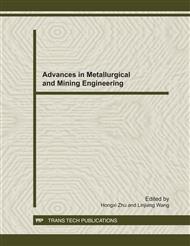[1]
Materials for the December 4-5, 2008 Meeting of the California Enviromental Contaminant Biomoditoring Program (CECBP) Scientific Guidance Panel (SGP). 2008, 1-5.
Google Scholar
[2]
R.R. Moskalyk, A.M. Alfantazi, Processing of vanadium: a review, Minerals Engineering. 16 (2003) 793-805.
DOI: 10.1016/s0892-6875(03)00213-9
Google Scholar
[3]
V.R. Rajab, Vanadium market in the world, Steel world. (2007) 19-22.
Google Scholar
[4]
D.X. Huang, Vanadium extraction and steelmaking, Beijing: Metallurgy Industry Press, 2000, 55-78.
Google Scholar
[5]
J.Z. Zhou, X.P. Chen, Vanadium resource exploitation 40 years in panzhihua: panzhihua iron and steel corporation, 2005, 45-102.
Google Scholar
[6]
J.C. Wang, Effect of Calcium on Leaching of Vanadium from Vanadium slag, Sichuan Nonferrous Metals. 4 (2004) 27-29.
Google Scholar
[7]
H.S. Wang, Extraction of vanadium from stone coal by roasting in the presence of sodium salts. 14 (1994) 49-52.
Google Scholar
[8]
Y.C. Dong, X.R. Wu, L. Yu, and L.S. Li, Fundamental research on vanadium recovering from V-bearing steelmaking slag, Engineering Science. 9 (2006) 63-68.
Google Scholar
[9]
A.H. Liu, L.S. Li, and L.Yu, The comparisons for vanadium extraction techniques from V-bearing sold wastes, J. Anhui University of Technology. 20 (2003) 126-141.
Google Scholar
[10]
J.Z. Hao, A.Q. Liu, Utilization of Wastes Produced in the Production Process of Vanadium, China Resources Comprehensive Utilization. 27 (2009) 7-9.
Google Scholar
[11]
R. R. Moskalyk, A.M. Alfantazi, Processing of vanadium: a review, Minerals Engineering. 16 (2003) 793-805.
DOI: 10.1016/s0892-6875(03)00213-9
Google Scholar
[12]
Y.Z. Lan, J. Liu, Review of Vanadium Processing in China, Engineering Science. 3 (2005) 58-62.
Google Scholar
[13]
H.W. Ge,; C. Wei, G. Fan, M.T. Li, Z.G. Deng, and C.X. Li, Pathbreaking Experimentation Study of a New Leaching Technology of Extracted Vanadium Residue by Acid Leaching Under Oxygen Pressure, Shanxi Metallurgy. 6 (2008) 17-19.
Google Scholar
[14]
D.H. Chen, Q.F. Yue, The novel technology research of extracting vanadium again from extracted vanadium residue, Iron Steel Vanadium Titanium. 4 (1992) 1-6.
Google Scholar
[15]
Y. Zhang, S.L. Zheng, H.B. X u, H. Du, and Y. Zhang, Decomposition of chromite ore by oxygen in molten NaOH-NaNO3, International Journal of Mineral Processing. 95 (2010) 10-17.
DOI: 10.1016/j.minpro.2010.03.005
Google Scholar
[16]
H. Du, L.J. Li, S.N. Wang, S.L. Zheng, B. Liu, etc, A method of recovery vanadium from extracted vanadium slag. Chinese Patent.
Google Scholar
[17]
Beijing Petrochemical Engineering Co., Ltd. Physical and Chemical Constant Handbook of Chlor-alkali Industry. Chemical Industry Press, Beijng. 1988, 181-201.
Google Scholar
[18]
D.C. Mo, Kinetics of metallurgy, Changsha: Central South China University of Technology Press. 1985, 173.
Google Scholar


